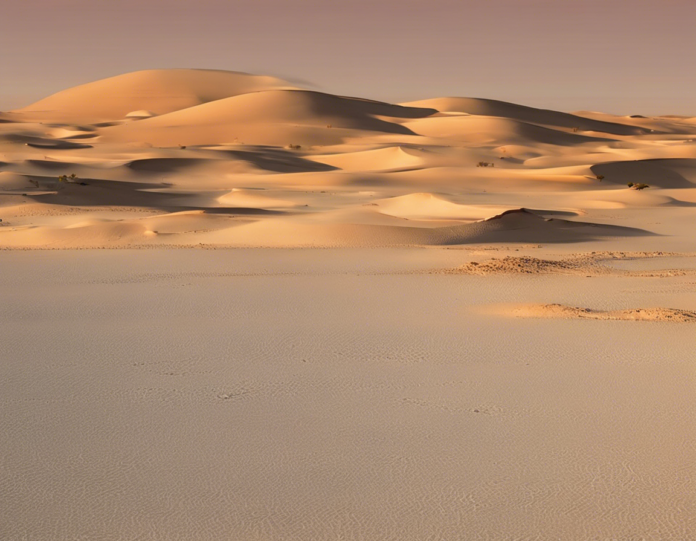Imagine driving through a vast desert landscape, with waves of heat rising from the sun-soaked sand dunes ahead. As you journey through this arid expanse, you suddenly see a shimmering pool of water in the distance. You may rub your eyes in disbelief, knowing full well that water bodies are a rare sight in deserts. This optical illusion, known as a mirage, has fascinated and mystified people for centuries. But what exactly causes this surreal phenomenon?
Understanding Mirage: The Basics
A mirage is a naturally occurring optical illusion that occurs when light rays are bent, or refracted, due to sharp temperature variations in the air. This bending of light creates deceptive images that appear displaced from the actual position of the object, distorting our perception of reality.
Types of Mirages
1. Inferior Mirage
- Description: This type of mirage occurs close to the ground on hot surfaces like asphalt, sand, or pavement.
- Cause: The air near the ground is significantly warmer than the air above it, leading to light rays bending upwards.
2. Superior Mirage
- Description: Superior mirages are observed above the horizon, making distant objects appear higher or distorted.
- Cause: Cold air is trapped under warmer air, causing light to refract downwards, creating a deceptive image.
Mirage and Heat: The Connection
Heat plays a crucial role in the formation of mirages. During the day, the sun beats down on the ground, heating it up. This warmth then radiates into the air just above the surface, creating stark temperature gradients. As a result, the air near the ground becomes significantly hotter than the air at higher elevations, causing light rays to refract and creating mirages.
The Science of Refraction
Refraction is the phenomenon where light bends as it passes through mediums with different densities. In the case of mirages, the air is the medium through which light travels. When light encounters a sharp change in air density due to temperature variations, it bends, creating optical illusions. This bending can make objects appear displaced from their actual positions, leading to the mirage effect.
Factors Influencing Mirage Formation
1. Temperature Gradient
- Description: Sharp temperature differences between layers of air are critical for mirages to form.
- Impact: Greater temperature differentials amplify the refractive effects, enhancing the mirage’s intensity.
2. Humidity Levels
- Description: Dry air is more conducive to mirage formation due to its lower refractive index compared to humid air.
- Impact: Lower humidity levels facilitate clearer and more defined mirages.
3. Surface Characteristics
- Description: Smooth, flat surfaces like deserts or roads enhance mirage formation by providing a uniform medium for light to travel through.
- Impact: Irregular surfaces may distort mirage properties or inhibit their formation.
Famous Mirage Examples
1. Fata Morgana
- Description: A complex form of mirage named after the Arthurian sorceress, Morgana.
- Features: Inverted and distorted images of distant objects, often observed in polar regions.
2. Highway Mirage
- Description: Commonly seen on hot roads, giving the illusion of water pools or oil spills.
- Features: Evaporative mirages that vanish upon closer inspection.
Debunking Myths About Mirages
-
Mirages are not Supernatural: Despite their surreal appearance, mirages are purely natural optical phenomena with a scientific basis.
-
Not Always Heat-Related: While heat-induced mirages are common, other factors like atmospheric pressure differentials can also create them.
-
Mirages Are Temporary: These illusions are fleeting and depend on ever-changing atmospheric conditions, disappearing as quickly as they form.
FAQs About Mirage Phenomenon
Q1: Are mirages only seen in deserts?
A1: While deserts provide ideal conditions for mirages, they can occur in any location with significant temperature differentials, including cold environments like polar regions.
Q2: Can mirages be captured on camera?
A2: Yes, mirages can be photographed, but their intensity and clarity may vary based on environmental conditions and camera settings.
Q3: Do mirages change with the time of day?
A3: Yes, mirage properties can vary throughout the day as temperature differentials shift, affecting the refractive patterns of light.
Q4: Can mirages be dangerous for drivers?
A4: Mirage distortions can confuse drivers, leading to misjudgments of distance and speed. It’s essential to remain vigilant in mirage-prone areas.
Q5: Can mirages occur over bodies of water?
A5: Yes, mirages are observed over not just land but also bodies of water, where temperature differentials between water and air create similar refractive effects.
Q6: Do animals experience mirages?
A6: There is no concrete evidence of animals perceiving mirages in the same way humans do, as their vision and depth perception differ from ours.
Q7: Can mirages be predicted?
A7: While atmospheric conditions conducive to mirages can be forecasted, the exact timing and locations of mirages are challenging to predict with precision.
Q8: Can mirages be used for scientific research?
A8: Mirage behavior can provide insights into air density variations, aiding studies on atmospheric optics, and light refraction principles.
Q9: Are mirages similar to optical illusions?
A9: Yes, mirages can be considered natural optical illusions, where environmental factors create deceptive visual effects.
Q10: Are mirages solely visual or do they affect other senses?
A10: Mirages primarily impact visual perception by distorting images, but they do not alter other senses like touch, taste, or smell.
In conclusion, understanding the science behind mirages unveils the mysteries of these captivating illusions that have intrigued observers for centuries. From the deserts of the Sahara to the icy landscapes of Antarctica, mirages remind us of the intricate interplay between light, heat, and the atmosphere, shaping our visual reality in unexpected ways.
